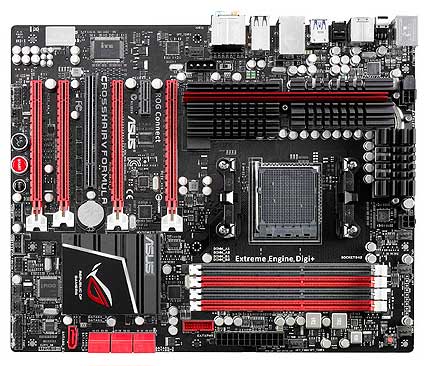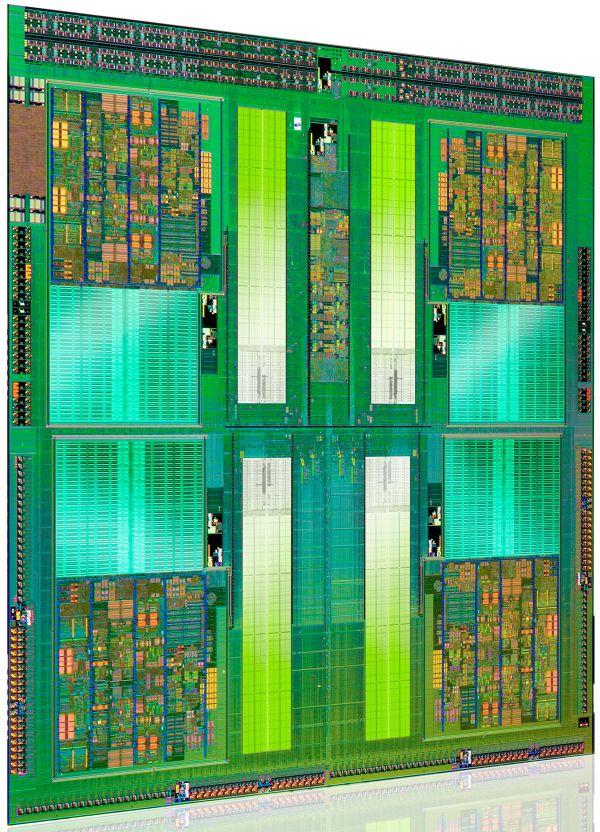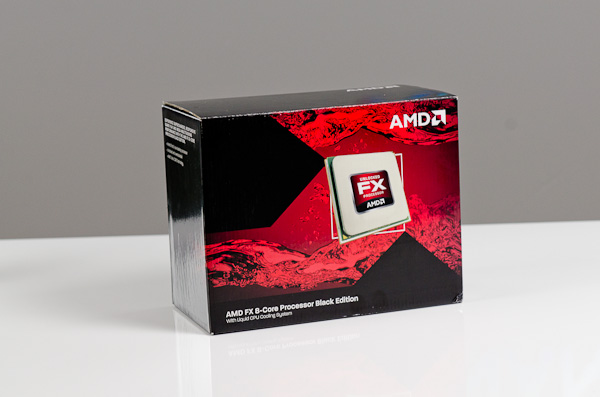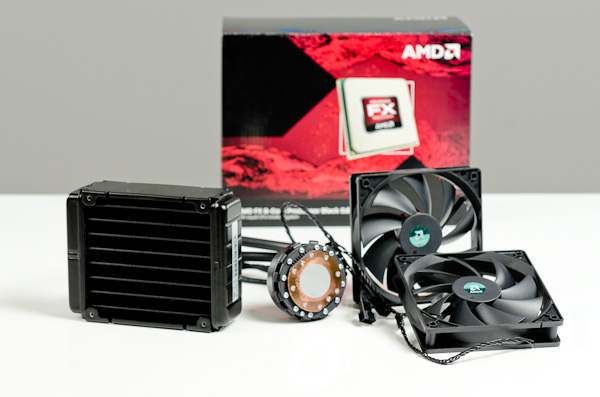The Bulldozer Review: AMD FX-8150 Tested
by Anand Lal Shimpi on October 12, 2011 1:27 AM ESTAMD has been trailing Intel in the x86 performance space for years now. Ever since the introduction of the first Core 2 processors in 2006, AMD hasn't been able to recover and return to the heyday of the Athlon 64 and Athlon 64 X2. Instead the company has remained relevant by driving costs down and competing largely in the sub-$200 microprocessor space. AMD's ability to hold on was largely due to its more-cores-for-less strategy. Thanks to aggressive pricing on its triple and hexa-core parts, for users who needed tons of cores, AMD has been delivering a lot of value over the past couple of years.
Recently however Intel has been able to drive its per-core performance up with Sandy Bridge, where it's becoming increasingly difficult to recommend AMD alternatives with higher core counts. The heavily threaded desktop niche is tough to sell to, particularly when you force users to take a significant hit on single threaded performance in order to achieve value there. For a while now AMD has needed a brand new architecture, something that could lead to dominance in heavily threaded workloads while addressing its deficiencies in lightly threaded consumer workloads. After much waiting, we get that new architecture today. Bulldozer is here.
It's branded the AMD FX processor and it's only available in a single die configuration. Measuring 315mm2 and weighing in at around 2 billion transistors (that's nearly GPU-sized fellas), Bulldozer isn't that much smaller than existing 45nm 6-core Phenom II designs despite being built on Global Foundries' 32nm SOI process. Both die area and transistor count are up significantly over Sandy Bridge, which on Intel's 32nm HKMG process is only 995M transistors with a die size of 216mm2. This is one big chip.
| CPU Specification Comparison | ||||||||
| CPU | Manufacturing Process | Cores | Transistor Count | Die Size | ||||
| AMD Bulldozer 8C | 32nm | 8 | 1.2B* | 315mm2 | ||||
| AMD Thuban 6C | 45nm | 6 | 904M | 346mm2 | ||||
| AMD Deneb 4C | 45nm | 4 | 758M | 258mm2 | ||||
| Intel Gulftown 6C | 32nm | 6 | 1.17B | 240mm2 | ||||
| Intel Nehalem/Bloomfield 4C | 45nm | 4 | 731M | 263mm2 | ||||
| Intel Sandy Bridge 4C | 32nm | 4 | 995M | 216mm2 | ||||
| Intel Lynnfield 4C | 45nm | 4 | 774M | 296mm2 | ||||
| Intel Clarkdale 2C | 32nm | 2 | 384M | 81mm2 | ||||
| Intel Sandy Bridge 2C (GT1) | 32nm | 2 | 504M | 131mm2 | ||||
| Intel Sandy Bridge 2C (GT2) | 32nm | 2 | 624M | 149mm2 | ||||
Update: AMD originally told us Bulldozer was a 2B transistor chip. It has since told us that the 8C Bulldozer is actually 1.2B transistors. The die size is still accurate at 315mm2.
Architecturally Bulldozer is a significant departure from anything we've ever seen before. We'll go into greater detail later on in this piece, but the building block in AMD's latest architecture is the Bulldozer module. Each module features two integer cores and a shared floating point core. FP hardware is larger and used less frequently in desktop (and server workloads), so AMD decided to share it between every two cores rather than offer a 1:1 ratio between int/fp cores on Bulldozer. AMD advertises Bulldozer based FX parts based on the number of integer cores. Thus a two module Bulldozer CPU, has four integer cores (and 2 FP cores) and is thus sold as a quad-core CPU. A four module Bulldozer part with eight integer cores is called an eight-core CPU. There are obvious implications from a performance standpoint, but we'll get to those shortly.
The FX Lineup
There are a total of 7 AMD FX CPUs that AMD is announcing today, although only four are slated for near-term availability.
| CPU Specification Comparison | |||||||||
| Processor | Cores | Clock Speed | Max Turbo | NB Clock | L2 Cache | TDP | Price | ||
| AMD FX-8150 | 8 | 3.6GHz | 4.2GHz | 2.2GHz | 8MB | 125W | $245 | ||
| AMD FX-8120 | 8 | 3.1GHz | 4.0GHz | 2.2GHz | 8MB | 95W/125W | $205 | ||
| AMD FX-8100* | 8 | 2.8GHz | 3.7GHz | 2GHz | 8MB | 95W | N/A | ||
| AMD FX-6100 | 6 | 3.3GHz | 3.9GHz | 2GHz | 6MB | 95W | $165 | ||
| AMD FX-4170* | 4 | 4.2GHz | 4.3GHz | 2.2GHz | 4MB | 125W | N/A | ||
| AMD FX-B4150* | 4 | 3.8GHz | 4GHz | 2.2GHz | 4MB | 95W | N/A | ||
| AMD FX-4100 | 4 | 3.6GHz | 3.8GHz | 2GHz | 4MB | 95W | $115 | ||
| AMD Phenom II X6 1100T | 6 | 3.2GHz | 3.6GHz | 2GHz | 3MB | 125W | $190 | ||
| AMD Phenom II X4 980 | 4 | 3.7GHz | N/A | 2GHz | 2MB | 125W | $170 | ||
The FX-8150, 8120, 6100 and 4100 are what's launching today. The first digit in AMD's FX model numbers indicates the number of cores with the 8150 and 8120 boasting eight, while the 6100 only has six active integer cores (three Bulldozer modules). The FX-4100 features four integer cores. L2 cache scales with core count (2MB per module), while the L3 cache size remains fixed at 8MB regardless of SKU.
North Bridge and L3 cache frequency alternate between 2.0GHz and 2.2GHz depending on the part. TDPs range between 95W and 125W as well, with the FX-8120 being offered in both 125W and 95W versions.
There's only a single Bulldozer die. The 6 and 4 core versions simply feature cores disabled on the die. AMD insists this time around, core unlocking won't be possible on these harvested parts.
The huge gap in clock speed between the 8120 and 8150 are troubling. Typically we see linear frequency graduations but the fact that there's a 16% difference between these two SKUs seems to point to process problems limiting yield at higher frequencies—at least for the 8-core version.
Outside of the quad-core and hex-core Bulldozer pats, the only other FX processor able to exceed the 3.3GHz clock speed of the Phenom II X6 1100T is the 8150. And if you include quad-core Phenom II parts in the mix, only two Bulldozer parts ship at a higher stock frequency than the Phenom II X4 980. Granted Turbo Core will help push frequencies even higher, but these low base frequencies are troubling. For an architecture that was designed to scale to clock speeds 30% higher than its predecessor, Bulldozer doesn't seem to be coming anywhere close.
The entire FX lineup ships unlocked, which allows for some easy overclocking as you'll see soon enough.
Motherboard Compatibility
AMD is certifying its FX processors for use on Socket-AM3+ motherboards. Owners of standard AM3 motherboards may be out of luck, although motherboard manufacturers can choose to certify their boards for use with Bulldozer if they wish to do so. From AMD's perspective however, only AM3+ motherboards with BIOS/UEFI support for Bulldozer are officially supported.
All existing AM2/AM2+/AM3/AM3+ heatsinks should work with the FX processor; they simply need to be rated for the TDP of the processor you're looking to cool.

For this review, AMD supplied us with ASUS' Crosshair V Formula AM3+ motherboard based on AMD's 990FX chipset.
AMD does offer six 6Gbps SATA ports on its 990FX chipset, a significant upgrade from the two 6Gbps ports on Intel's 6-series chipsets. Unbuffered ECC memory is also supported for those who desire the added security, once again a feature not supported on Intel's consumer grade 6-series chipsets.
Despite AMD's trend towards releasing APUs with integrated GPUs (thus requiring a new socket), AMD insists that the AM3+ platform will live to see one more processor generation before it's retired.
AMD's Liquid CPU Cooling System
Alongside its new FX processors AMD is introducing its first branded liquid cooling system manufactured by Asetek.
AMD's cooling system is similar to other offerings from companies like Antec and Corsair. The system is self contained, you never have to worry about adding any more liquid to it.
Attach the cooling module to your CPU socket via a simple bracket, and affix the radiator to your case and you're good to go. The radiator is cooled via two 120mm fans, also included in the box.
AMD doesn't have an exact idea on pricing or availability of its liquid cooling solution, but I'm told to expect it to be around $100 once available. My sample actually arrived less than 12 hours ago, so expect a follow up with performance analysis later this week.
The Roadmap
For the first time in far too long, AMD is actually being very forthcoming about its future plans. At a recent tech day about Bulldozer, AMD laid out its CPU core roadmap through 2014. The code names are below:
Piledriver you already know about, it's at the heart of Trinity, which is the 2—4 core APU due out in early 2012. Piledriver will increase CPU core performance by around 10—15% over Bulldozer, although it will initially appear in a lower performance segment. Remember that final generation of AM3+ CPU I mentioned earlier? I fully expect that to be a GPU-less Piledriver CPU due out sometime in 2012.
Steamroller will follow in 2013, again improving performance (at the core level) by around 10—15%. Excavator will do the same in 2014. AMD believes that these performance increases will be sufficient to keep up with Intel over time, however I'll let you be the judge of that once we get to the Bulldozer performance numbers.
The other thing to note about AMD's roadmap is it effectively puts the x86 business on an annual cadence, in line with what we've seen from the AMD GPU folks. Although AMD isn't talking about what process nodes to expect all of these cores at, it looks like AMD will finally have an answer to Intel's tick-tock release schedule moving forward.























430 Comments
View All Comments
actionjksn - Thursday, October 13, 2011 - link
AMD Nailpuller? That was some funny shit right there HA HA HASpam not Spam - Wednesday, October 12, 2011 - link
Just skimmed the review; not as awesome as I had hoped for, sadly. That being said, I'm thinking it might well be a nice improvement for the stock, C2D Q6600 in my Dell. I could go Intel, obviously, but... I dunno. I've got an odd fascination with novel things, even if they are rough to begin with. Hell, I've even got a WP7 phone :pwolfman3k5 - Wednesday, October 12, 2011 - link
Then make sure to get a quality power supply and motherboard to go with it. Also, your power bill will increase, but not directly from the Bulldozer CPU, nope, but from all the heat that it will make... you will need to run your air conditioner which is a power hog./* Patiently waiting for AMD's next gen architecture codenamed "Bendover" */
ckryan - Wednesday, October 12, 2011 - link
Is 'ScrewdOver' next on the roadmap after 'Bendover'? I'll have to look in the official AMD leaked slide repository.I still think some intrepid AMD faithful will try BD out just because they're wired that way, and many of the are going to like it. I bet it compares better to Lynnfield than Sandy Bridge... Except Ivy Bridge is closer in the future than SB's launch is in the past. This could be an interesting and relevant product after a few years, but the need is dire now. AMD is going to kill off the Phenom II as fast as possible.
themossie - Wednesday, October 12, 2011 - link
Bendover -> ScrewdOver -> Screwdriver (I'll bring the OJ) -> Piledriver.Courtesy of numerous internal leaks at AMD.
themossie - Wednesday, October 12, 2011 - link
My apologies, didn't realize Piledriver was real.bill4 - Wednesday, October 12, 2011 - link
AKA, the reason all of us who are commenting are reading this review. Gaming performance. And AMD chose not to even compete there. Bunch of monkey overs at AMD CPU engineering?It's now a non starter in the enthusiast market.
I've often though recently that AMD (or any manufacturer really, but AMD as a niche filler would be a more obvious choice given their market position) would do well to try to position itself as the gamers choice, and even design it's CPU's to excel in gaming at the expense of some other things at times. I really suspect this strategy would lead to a sales bonanza. Because really the one area consumers crave high performance is pretty much, only gaming. It's the one reason you actually want a really high performance CPU (provided you dont do some sort of specialized audio/video work), instead of just "good enough" which is fine for general purpose desktoping.
Instead they do the exact opposite with Bulldozer, facepalm. Bulldozer is objectively awful in gaming. Single handedly nobody who posts at any type of gaming or gaming related forum will ever buy one of these. Unbelievable.
Perhaps making it even more stinging is there was some pre-NDA lift supposed reviewer quote floating around at about how "Bulldozer will be the choice for gamers" or something like that. And naturally everybody got excited because, that's all most people care about.
Combine that with the fact it's much bigger and hotter than Intel's, it's almost a unmitigated disaster.
This throws AMD's whole future into question since apparently their future is based on this dog of a chip, and even makes me wonder how long before AMD's engineers corrupt the ATI wing and bring the GPU side to disaster? The ONLY positive thing to come out of it is that at least AMD is promising yearly improvements, key word promising. Even then absolute best case scenario is that they slowly fix this dog in stages, since it's clearly a broken architecture. And that's best case, and assumes they will even meet their schedule.
Anand lays so much of the blame at clockspeed, hinting AMD wanted much more. But even say, 4.3 ghz Bulldozer, would STILL be a dog in all important gaming, so there's little hope.
shompa - Wednesday, October 12, 2011 - link
I have used many AMD systems. Have deployed 1000 of AMD CPU inside Unix workstations at my old work. I cheer for AMD.But.
AMD is going to have a hard time ahead. Selling its fabs to Global foundries was the biggest mistake of them all.
We are in the post PC world. If Tablets are computers: 2012 20% of PCs will use ARM. This is many lost CPU sales for AMD/Intel.
I predict that AMD will be gone within 3 years. Maybe someone buys them? After the settlement with Intel, AMD now can transfer its X86 license to the next buyer. (pending Intels approval)
Maybe Google could buy AMD and build complete computers ?
wolfman3k5 - Wednesday, October 12, 2011 - link
I see two things that might happen to AMD1) They will transform in to a GPU manufacturer completely (and of course they will make those silly APUs)
2) If that damn x86 license is transferable, they could merge with NVidia. Neither of these two companies looks to hot these days, so they might as well work together.
philosofool - Thursday, October 13, 2011 - link
We may be in the "post PC" era, but don't count x86 out. Recent studies indicate there's a corollary to Moore's law that applies to compute power per watt; the study goes back to 1961. This suggests that x86 is only a few years away from running on mobile devices, which is what MS and Intel are betting on. And frankly, it makes sense. Ultimately, I don't want two different things (a mobile device and a PC), I want a PC in my pocket and one on my desk.